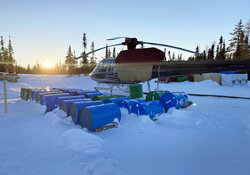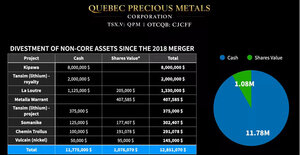The Gold Report: Given how troubled the junior gold space has been since 2011, why should investors continue to place their money there rather than the Dow Jones Industrials, which go from strength to strength?
Lawrence Roulston: The simple answer is that there are extraordinary bargains to be had in the junior resource space right now. We're seeing a bifurcation in the sector as the quality companies are beginning to move up, while the majority of companies are still on a downtrend. Anyone who can differentiate between the good companies and the others has the potential to make a lot of money.
A shocking revelation about the status of U.S. gold is on the horizon and it has the potential to change America forever.
A change that could send global markets into a tail spin...shrink 401ks and IRAs by 40%...and send gold soaring to $6,300.
Click here to learn how you can be prepared—and profit.
TGR: You've argued that it's a fool's errand trying to predict the near-term outlook for metals prices, especially gold, as there are too many variables involved, and the variables change too quickly. Should investors therefore base their decisions on an assumed future gold price of roughly $1,250/ounce ($1,250/oz)?
LR: When I look at a company in the gold space I'm using that number as a baseline. When I examine companies, I consider them first and foremost as investments in projects and management. Metal prices are a secondary consideration. If it doesn't make sense at $1,250/oz, then it's not a good investment. If the gold price rises, that's a bonus.
"Balmoral Resources Ltd. has had tremendous exploration success in Québec."
TGR: Gold prices and gold equities have spiked in recent weeks due to rising tensions in Ukraine and the chaos in Iraq. How should investors regard these events?
LR: I think they are primarily short-term reactions. These events cause prices to rise one day and fall the next. And they are really hard to predict.
TGR: A gold price of under $1,300/oz, as compared to over $1,900/oz in 2011, makes the all-in production cost crucial. In today's market, how high can production costs go and still remain acceptable?
LR: That's a tough and a complex question. The all-in sustaining cost incorporates a large amount of capital expenditure that is spent to get the mine into production. In the long term, of course, it's very important. If the capital is already committed and the company is generating profits on the basis of its cash cost, it makes sense for the company to continue operating in the short term.
It all comes down to margins. Most of my attention is devoted to companies that are in the development stage, not the production stage. Mine developers must be able to demonstrate substantial margins based on the current gold price.
TGR: Is an all-in cost of $1,000/oz still doable, or must costs be lower than that?
LR: I look at specific companies, and I tend to evaluate them based less on all-in sustaining costs and more from the perspective of discounted net cash flow.
TGR: You have declared, "We do not need higher metal prices to make money in the mining business. We just need to own companies with high-quality metal deposits." How do you define high quality?
"Columbus Gold Corp. is in the strong position of becoming a significant gold producer."
LR: Important determinants are grade, metallurgy and size. Grade is really a function of the specific circumstances of any given deposit. A big open-pit deposit at 1 gram per ton (1 g/t) may make a lot of sense. In an underground situation you probably need a much higher grade, perhaps as high as 8–10 g/t. But grade is only one factor. Metallurgy is important: How is the metal recovered? There is a big range of costs across the different recovery techniques. In some cases, it simply isn't economic to recover the metal. Size is important too, as well as the ability to meet a production level that will result in interest from larger companies.
It's really hard for a small company to develop a single mine and make money off it. The real money is made when those deposits are rolled up into larger, multi-mine producing companies. I ask the question, "Will a particular deposit be of interest to a midtier or a larger production company in terms of size, production profile, location and other relevant criteria."
TGR: Since 2011, many gold companies have come to grief because they accumulated ounces for their own sake. When larger companies are looking to buy smaller companies and their assets, what are they looking for?
LR: Barrick Gold Corp. (ABX:TSX; ABX:NYSE) wrote off $5.1 billion ($5.1B) from the value of Pascua-Lama, and Kinross Gold Corp. (K:TSX; KGC:NYSE) wrote off $3.2B from the value of Red Back. These are both big, low-grade deposits. So these kinds of deposits have gone out of style.
"Klondex Mines Ltd. could have a very profitable underground operation."
And yet a bidding war broke out for Osisko Mining Corp. (OSK:TSX), which was eventually bought for $3.5B by Yamana Gold Inc. (YRI:TSX; AUY:NYSE; YAU:LSE) and Agnico-Eagle Mines Ltd. (AEM:TSX; AEM:NYSE). Osisko's primary asset was the Canadian Malartic mine in Quebec, which produces gold at only 1 g/t. So the blanket condemnation of low-grade deposits doesn't really make sense. Potential buyers are most interested in the specific characteristics of any particular deposit. High-grade deposits are back in style, but the challenge is finding deposits that are both large and high grade.
TGR: You've noted that 12 of the companies your newsletter follows have raised a total of $184 million ($184M) so far this year. Besides high-quality deposits, what else do these companies have in common?
LR: Quality management is the crucial attribute of all companies able to raise money in this market. People committed to success. People with skills and experience but also the drive and determination sufficient to overcome obstacles and move projects forward. We hear a lot of people complaining about how difficult it is to raise money today. That attitude is just not going to cut it. There is money available. Management just has to justify to the potential investors that they will achieve a decent return commensurate with the level of risk.
We need managements than can recognize the benefits of a market like this. Many of the companies I follow look at current conditions and see opportunities rather than challenges. Opportunities such as buying high-quality deposits from distressed companies.
TGR: When we speak of quality management, does this require individuals who have proven they can bring a mine into production or sell it to a larger company for a healthy profit?
LR: The fact that a management team has achieved success in the past is a pretty good indicator of its ability to repeat this success. Many analysts consider track record the determining factor in management. I agree.
But it's also important to look for rising stars. One of the great joys I've had in my career has been identifying the young people who will become the success stories of the future. That involves a lot of hard work: meeting them face to face and really understanding where they're coming from and what their plans are. This is a good way to make good profits in mining investment because the companies with established management trade at a premium. Investors who find companies with rising stars benefit from a much lower share-price starting point.
TGR: As you mentioned, many people complain how difficult it is to raise money today. Of course it is difficult, and given this fact, how important is it for companies to have financing experts in management or on their boards?
LR: It is critically important. A really successful management team needs a range of skills, and that range of skills is typically much broader than one or even several people can have independently. You need a team that boasts engineering and geological skills, financial skills, as well as someone who can coordinate these skills and keep the project on track.
In today's market, it's very difficult for small mining companies to acquire all these necessary skills. One solution is collective management: a pool of people managing several different companies. This enables them to collectively have all the required skills and to spread the costs over a number of companies.
TGR: Which gold junior operating in Canada is your favorite right now?
LR: Balmoral Resources Ltd. (BAR:TSX; BAMLF:OTCQX). The company has had tremendous exploration success in Québec. It made a substantial gold discovery at Martiniere and continues to expand its limits, adding size and scale.
TGR: Where in Quebec are Balmoral's properties located?
LR: Balmoral has huge holdings that extend for about 80 kilometers into the Sunday/Detour Lake deformation zone of the Abitibi Greenstone Belt. Its properties are south of James Bay, just on the other side of the Ontario border. On the Ontario side, Detour Gold Corp. (DGC:TSX) is producing over 100,000 ounces (100 Koz) of gold quarterly from a resource in the order of 30 million ounces (30 Moz).
Balmoral has decided, quite wisely, to focus on Martiniere, much of which remains unexplored.
TGR: In addition to gold at Martiniere, Balmoral also has the Grasset nickel-platinum group metal (PGM) project. How does the latter make Balmoral more prospective?
LR: Grasset is really a standalone project. I'm just guessing here, but it's the sort of thing it might be able to spin off or sell. Balmoral is likely to remain a gold company because that will result in a higher valuation than base metals.
TGR: Balmoral announced June 4 a $4M bought-deal, flow-through private placement. How does that set it up for financing?
LR: Balmoral has enough money to get through 2015 and possibly beyond.
TGR: When can we expect an initial resource estimate for Martiniere?
LR: Probably by the end of the summer drilling season, but keep in mind Balmoral has only begun to define that deposit.
TGR: How do you rate Balmoral's management?
LR: Very high. CEO Darin Wagner has had considerable success, including the sale of West Timmins Mining to Lake Shore Gold Corp. (LSG:TSX) for $424M in 2009. Other members of the geological and management team have had a considerable degree of exploration success.
TGR: What's your favorite gold play in South America?
LR: Columbus Gold Corp. (CGT:TSX.V). Its Paul Isnard project in French Guiana has 58.1 million tons at 2.22 g/t gold: 4.15 Moz. Nordgold N.V. (NORD:LSE) is to acquire a majority position in Paul Isnard in exchange for funding it through to feasibility.
TGR: The company announced May 5 that the Paul Isnard resource is to be re-evaluated by a different engineering company. Should investors be worried?
LR: I think it's just a blip. I've spent time talking to the company, and the re-evaluation should have no material impact on the overall size and quality of Paul Isnard. I expect that the revised resource number should come back very close to what was announced previously.
Nordgold made a $4.2M option payment May 23. If Columbus had any concern over the validity of the resource, I'm sure it would have asked for a deferral on that payment until the matter had been resolved, but it didn't. It's very clear that Nordgold is comfortable with the resource.
TGR: WheneverThe Gold Report asks experts about the best junior gold projects in the world, their lists invariably include Columbus. And yet the company's shares trade at only $0.45, and its market cap is only around $54M. How do you explain this?
LR: One of the challenges that Columbus faces with investors is that they don't really know much about French Guiana. They don't appreciate that it is a department of France ruled by French law and thus a very secure place for investment and very favorable for mine development.
Another factor is uncertainty or misunderstanding the joint venture with Nordgold. When a junior the size of Columbus has a deposit of such size, investors expect a takeover by a larger company. But Columbus' joint venture with Nordgold probably lessens the likelihood of Columbus being taken out. As it stands, Columbus is in the strong position of becoming a significant gold producer without much risk on the financial side.
TGR: Which junior gold company do you like in the United States?
LR: Klondex Mines Ltd. (KDX:TSX; KLNDF:OTCBB) in Nevada. The company just bought the high-grade producing Midas mine from Newmont Mining Corp. (NEM:NYSE). Many of the majors are going through asset rationalizations, and this presents company-making opportunities to juniors like Klondex.
TGR: How is the acquisition of Midas company-making?
LR: It's an excellent complement to Klondex's Fire Creek gold project 100 miles to the south, which is effectively in production. Fire Creek still needs a full-scale development permit, but Klondex is operating under a bulk-sampling permit with the ore being trucked to Midas. The Fire Creek ore is exceptionally high-grade: 284 Koz at 41.5 g/t Measured and Indicated and 424 Koz at 23.3 g/t Inferred. This means that the trucking cost is essentially inconsequential.
The Midas acquisition is a perfect fit. The Midas operating team is quite accomplished at high-grade underground mining situations, such as Fire Creek.
TGR: According to Klondex's April preliminary economic assessment (PEA), the all-in cost of Fire Creek gold is $636/oz. Impressive?
LR: It's a very attractive number based on the fact that no mill will be needed on site.
TGR: At the start of this interview, you mentioned the "extraordinary bargains" available today in the junior gold space. Which qualities distinguish a bargain?
LR: Many companies are bargains today, but a year from now they're still going to be bargains. When investors are trying to determine whether a low share price is really an opportunity, they should look for a trigger that will create a higher share price in the foreseeable future.
It comes back to management advancing projects and adding value, for instance, Klondex buying Midas, which gave it a short-term path to production for Fire Creek. Or Balmoral, which applied some really smart geological thinking to make a significant discovery and push up share price. Just sitting back waiting for the market to recover is not a viable business plan.
TGR: Is it possible that we might fairly soon get to the point where we stop talking about companies that clearly aren't going anywhere and focus entirely on companies with genuine prospects and that this new focus could engender a general recovery in the junior gold space?
LR: I would very much like to see investor focus shifting to companies with real merit. There are 2,000 companies in the North American junior resource space. Having so many diffuses investor attention and diffuses the talent pool to the point where most don't have realistic prospects of success. A number of struggling juniors have already gone into the marijuana business or other areas outside of mining. More power to them.
We need fewer companies with a greater concentration of talent providing a better focus for investors. It is now more important than ever for mining investors to be selective in their investments because only a few mining companies are going to prosper while most will continue to lose value until we see a general turnaround, which might take another year or two.
TGR: Lawrence, thank you for your time and your insights.
Lawrence Roulston is an expert in the identification and evaluation of exploration and development companies in the mining industry. He is a geologist, with engineering and business training, and more than 20 years of experience in the resource industry. He has generated an impressive track record for Resource Opportunities, a subscriber-supported investment newsletter.
Read what other experts are saying about:
Want to read more Gold Report interviews like this? Sign up for our free e-newsletter, and you'll learn when new articles have been published. To see recent interviews with industry analysts and commentators, visit our Streetwise Interviews page.
DISCLOSURE:
1) Kevin Michael Grace conducted this interview for Streetwise Reports LLC, publisher of The Gold Report, The Energy Report, The Life Sciences Report and The Mining Report, and provides services to Streetwise Reports as an independent contractor. He owns, or his family owns, shares of the following companies mentioned in this interview: None.
2) The following companies mentioned in the interview are sponsors of Streetwise Reports: Balmoral Resources Ltd., Columbus Gold Corp. and Klondex Mines Ltd. Streetwise Reports does not accept stock in exchange for its services.
3) Lawrence Roulston: I own, or my family owns, shares of the following companies mentioned in this interview: Klondex Mines Ltd. I personally am, or my family is, paid by the following companies mentioned in this interview: None. My company has a financial relationship with the following companies mentioned in this interview: None. I was not paid by Streetwise Reports for participating in this interview. Comments and opinions expressed are my own comments and opinions. I had the opportunity to review the interview for accuracy as of the date of the interview and am responsible for the content of the interview.
4) Interviews are edited for clarity. Streetwise Reports does not make editorial comments or change experts' statements without their consent.
5) The interview does not constitute investment advice. Each reader is encouraged to consult with his or her individual financial professional and any action a reader takes as a result of information presented here is his or her own responsibility. By opening this page, each reader accepts and agrees to Streetwise Reports' terms of use and full legal disclaimer.
6) From time to time, Streetwise Reports LLC and its directors, officers, employees or members of their families, as well as persons interviewed for articles and interviews on the site, may have a long or short position in securities mentioned. Directors, officers, employees or members of their families are prohibited from making purchases and/or sales of those securities in the open market or otherwise during the up-to-four-week interval from the time of the interview until after it publishes.










































